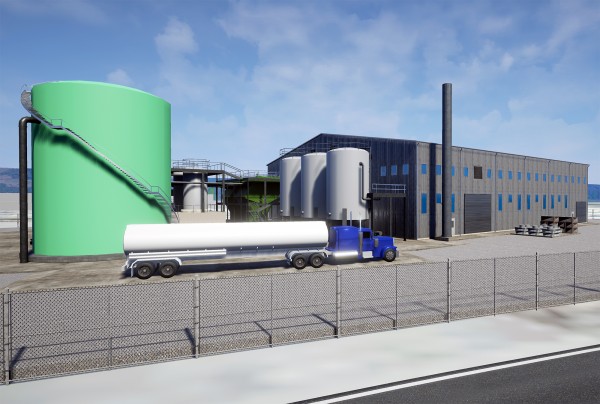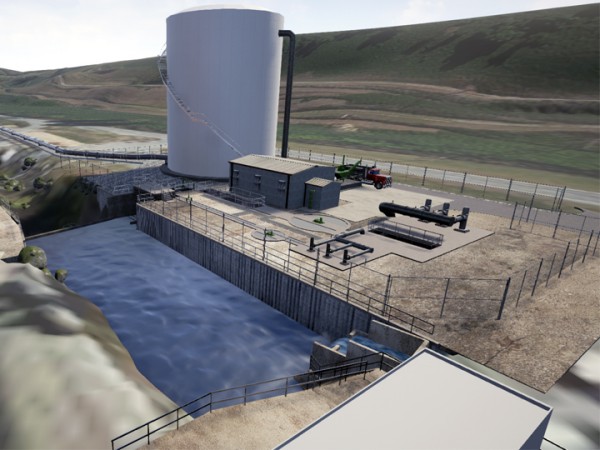
The planned Mercury Treatment Facility at the Y-12 National Security Complex in Oak Ridge. (Image courtesy UCOR/U.S. Department of Energy Oak Ridge Office of Environmental Management)
The U.S. Department of Energy has awarded a $91 million contract to build the Mercury Treatment Facility at the Y-12 National Security Complex.
It’s part of an effort to reduce the amount of mercury in East Fork Poplar Creek and allow the demolition of several large Y-12 buildings where mercury was used to help make nuclear weapons during the Cold War.
The contract, which could be in place for up to four years, was awarded to APTIM-North Wind Construction JV LLC, DOE said Tuesday.
In a press release, DOE said it received two proposals in response to a solicitation. There is no incumbent contractor for the work.
A groundbreaking was held at the site in November 2017, and early site preparation activities were started by other contractors in December 2017.
Officials sometimes refer to the area where part of the facility will be built as Outfall 200. That’s the area where the storm drain system at Y-12 discharges at the headwaters of Upper East Fork Poplar Creek. It’s in an area near the Beta 1 and Beta 3 buildings on the south side of Y-12’s main production area.
The contract work includes:
- safely building the Outfall 200 Mercury Treatment Facility Headworks, Transfer Pipeline, and Treatment Plant;
- conducting systems testing; and
- turning over facility management responsibilities to an operating contractor.
DOE said the Mercury Treatment Facility is a vital piece of infrastructure because it will help the Oak Ridge Office of Environmental Management fulfill its regulatory commitments to reduce mercury levels in East Fork Poplar Creek and enable large-scale cleanup and demolition to begin at Y-12. DOE cleanup work in Oak Ridge is expected to move to Y-12 and Oak Ridge National Laboratory after it’s completed at the East Tennessee Technology Park (the former K-25 site) around 2020.
“This facility is a central component of our cleanup strategy at Y-12,†OREM Manager Jay Mullis said in the press release. “We are incredibly grateful for the support we’ve received from Congress that allows us to move forward with construction, and we are excited for the opportunities and progress this project will help us achieve at one of the nation’s most important national security sites.â€
Y-12 was initially built in 1943 to enrich uranium as part of World War II’s Manhattan Project, but the site soon became an integral part of Cold War weapons production. The process that was used until 1963 to separate lithium for those operations required the use of thousands of pounds of mercury.
When complete, the new facility will allow the demolition of Alpha 4, Alpha 5, and Beta 4, large, deteriorated buildings that once used mercury and date back to the 1940s. After their removal, OREM will remediate the soils beneath them, DOE said.
The Mercury Treatment Facility will limit and control potential mercury releases as crews take down those buildings and address the soils, work that could disrupt the mercury-contaminated area on the west end of Y-12, the press release said.
The Mercury Treatment Facility will have two facilities in two separate areas that are connected by a pipeline. The first building, known as the headworks facility, will capture water traveling from the western side of Y-12. It will be built at Outfall 200.
The second part of the Mercury Treatment Facility will be the treatment facility itself. It will be built on the eastern side of Y-12. Water will flow through a pipeline from the headworks facility to the treatment facility. The treatment facility will be able to treat up to 3,000 gallons of water per minute, and it will include a two-million-gallon storage tank to collect stormwater.
Mercury contamination is one of the biggest problems remaining from the Cold War, U.S. Senator Lamar Alexander said during the groundbreaking ceremony in November 2017. Alexander announced the mercury cleanup effort in Oak Ridge in May 2013. He said he wanted to prevent mercury once used to make nuclear weapons from getting into waterways.
Officials said last year that construction of the Mercury Treatment Facility was expected to begin late this year, and the facility is expected to start operating in late 2022. They said then that work on the buildings could start by 2024, although it wasn’t immediately clear Wednesday morning if the schedule has remained the same.
During the groundbreaking last year, Mullis said the Mercury Treatment Facility will use technology that is not unique—it’s used in water treatment systems, he said—but it’s unique in terms of collecting mercury. It’s expected to reduce mercury concentrations to safe levels of parts per trillion. The mercury collected at the treatment facility will be packaged and disposed at appropriate sites, Mullis said.
Officials have been waiting to demolish four large Y-12 buildings—Alpha 2, Alpha 4, Alpha 5, and Beta 4—until the Mercury Treatment Facility is built because they want to use it to keep mercury out of the water as workers disturb the mercury-contaminated buildings and soils. When the soils and buildings have been disturbed in the past, they’ve released mercury, Mullis said in April last year.
Y-12 was initially built to enrich uranium for atomic bombs during World War II. It used mercury to separate lithium for nuclear weapons during the Cold War. The lithium separation operations started in 1955 and ended in 1963, and the plant used more than 20 million pounds of mercury. During that time, about 700,000 pounds of mercury were lost into buildings, soil, groundwater, and sediment. The U.S. Department of Energy said the mercury flowed through pumps, pipes, valves, and seals at high rates and sometimes escaped into the environment.
The Mercury Treatment Facility could reduce the flow of mercury, which travels from west to east at Y-12, by an estimated 84 percent. The treatment plant will be modular and officials will be able to scale it to allow for expansion and to provide flexibility.
East Fork Poplar Creek starts at a spring at Y-12 and flows through central Oak Ridge before joining West Fork Poplar Creek at East Tennessee Technology Park.
Learn more and see our story on last year’s groundbreaking ceremony here.
See the DOE press release here.
More information will be added as it becomes available.

The headworks for the planned Mercury Treatment Facility at the Y-12 National Security Complex in Oak Ridge. (Image courtesy UCOR/U.S. Department of Energy Oak Ridge Office of Environmental Management)
Most news stories on Oak Ridge Today are free, brought to you by Oak Ridge Today with help from our advertisers, contributors, and subscribers. This is a free story. Thank you to our advertisers, contributors, and subscribers. You can see what we cover here.
Do you appreciate this story or our work in general? If so, please consider a monthly subscription to Oak Ridge Today. See our Subscribe page here. Thank you for reading Oak Ridge Today.
Copyright 2018 Oak Ridge Today. All rights reserved. This material may not be published, broadcast, rewritten, or redistributed.





Leave a Reply